Prices for the design of fire extinguishing systems. Installation of an automatic fire extinguishing system. Fire alarm
With the development of modern fire safety systems, there are fewer reports of fires. Modern technologies allow you to effectively protect an office, warehouse, store, production area from damage that can be caused by fire. An important role in this is played by the competent design of fire extinguishing systems, in which everything must be foreseen.
We professionally carry out system design fire protection, and our right to these works is confirmed by the license of the Ministry of Emergency Situations. Our projects are created in compliance with all requirements and are always approved. The fire extinguishing project includes complete detailed documentation (layouts of system elements, calculation of equipment parameters and extinguishing substances), according to which the installation takes place quickly and without problems. The cost of a firefighting project always corresponds to its complexity and the volume of work performed.
Design features for the extinguishing mechanism and means
The design of automatic fire extinguishing systems has its own nuances in terms of the difference in their mechanism of action.
Sprinkler fire extinguishing systems
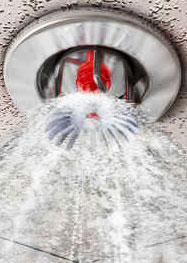 Sprinkler fire extinguishing systems are needed for rooms and places where a fire is very unavoidable high temperatures... The design of a sprinkler fire extinguishing system includes combating local fires as well as cooling important elements... Water is constantly in the system, and the sprinkler itself (sprinkler unit) is supplied with a thermal start mechanism. When the temperature rises to the designated level, the heat seal is unsoldered or the bulb covering the head bursts, and the liquid irrigates the planned area.
Sprinkler fire extinguishing systems are needed for rooms and places where a fire is very unavoidable high temperatures... The design of a sprinkler fire extinguishing system includes combating local fires as well as cooling important elements... Water is constantly in the system, and the sprinkler itself (sprinkler unit) is supplied with a thermal start mechanism. When the temperature rises to the designated level, the heat seal is unsoldered or the bulb covering the head bursts, and the liquid irrigates the planned area.
Deluge fire extinguishing systems
Deluge fire extinguishing systems used in larger areas. They must extinguish fires and prevent the spread of fire. Therefore, the design of a deluge fire extinguishing system poses the setting of water curtains as one of the tasks. A drencher, unlike a sprinkler, does not have thermal locks. Either a person or a system sensor starts the system. Such installations are normally empty and the extinguishing agent (water / foam) is supplied only after the signal. The deluge variant is more often installed in places where the risk of fire is low and the expected damage is negligible. A wall of water / foam extinguishes the fire and does not allow it to go further, therefore drenchers are often placed in the corridors and doorways as well as around potential fires.
The means that the system uses to extinguish a fire also plays a role:
- Design systems powder fire extinguishing provides for the operation of special equipment with mineral salt saturated with special additives (designers determine their composition according to the purpose of the system).
- Design water fire extinguishing systems uses for the calculation the usual and most common installations that extinguish the flame by injecting water. Likewise with foam fire extinguishing when special foam is used.
- Design gas fire extinguishing systems- a rare option, but one of the oldest. To extinguish the fire, installations that spray carbon dioxide are used. Such systems are sometimes installed in industrial facilities for specific purposes.
Foam fire extinguishing
Foam fire extinguishing is effective by combining the advantages of using water and dry components on fires. A foam fire extinguishing project is being developed to ensure rapid elimination of fires at facilities where the use of powder formulations or water will be useless or ineffective. Examples of such objects are warehouses (storage facilities) paints and varnishes, fuels and lubricants, oil and oil products.
Water mist fire extinguishing
In a fire extinguishing project water mist implemented efficient system elimination of fires, allowing to reduce the cost of installation and implementation, as well as to eliminate damage from an abundant flood of water. The high penetrating power of water mist provides reliable fire extinguishing at low material consumption. The systems are recommended for use in archival, museum, office premises, libraries.
Aerosol fire extinguishing
The effectiveness of aerosol fire extinguishing lies in the extinguishing capabilities of the hot stream of solid particles and gases formed during combustion chemical substances included in the aerosol mixture. In the design of the aerosol fire extinguishing system, the main equipment is a fire extinguishing aerosol generator (GOA), which is triggered automatically or manually activated. The use of the systems is universal, but there is a ban on using it in rooms where it is not possible to evacuate people before turning on the GOA.
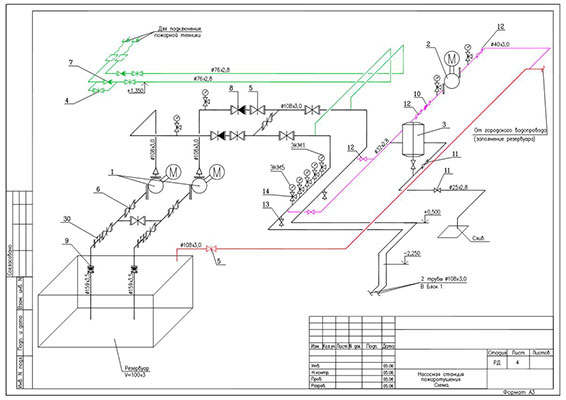 System design fire safety is performed in several stages:
System design fire safety is performed in several stages:
- Study and assessment of the premises that the system will protect. Determination of the premises in which it is necessary to mount the ceiling made of expanded polystyrene tiles. When the territory is determined, the actual design of water and foam begins. automatic installations fire extinguishing.
- Determination of the points of location of the irrigation heads.
- Determining the location of the pump.
- Determination of extinguishing agent supply routes (water / foam / powder).
- Determination of the location of fire sensors.
- Determination of the location of water intake points.
- Calculation of pump power, tank volume, type of substance (water / foam / powder), type of system (deluge / sprinkler).
- Project approval. We can accompany him with this to speed up the approval process.
Since we carry out the design and installation of fire extinguishing systems, after the approval of the project, we can continue to work with you already as an installation company.
During installation, our specialists:
- Equipment is selected according to the parameters calculated in the project and delivered to the object.
- They are laying cable routes and water pipelines.
- Install control panels, a pump, sensors, irrigation devices.
- The system is integrated into engineering networks.
- Commissioning works are carried out.
As a result, you get working system fire suppression that we can vouch for. The territory entrusted by you will no longer be threatened by fire.
NPF "Garant" offers design services for fire extinguishing systems for industrial, administrative, retail, public and other facilities. We will carry out the whole range of works with a quality guarantee.
The design of fire extinguishing systems is one of the most complex and responsible types of development. The creation of a project requires specialized knowledge and experience, as well as the availability of SRO approvals and licenses from the Ministry of Emergency Situations of the Russian Federation. Our company has all the necessary licenses of the Ministry of Emergency Situations of Russia and SRO approvals for production design work at industrial and civil construction sites.
For objects with foreign capital participation, the project often requires compliance with international standards, therefore for such customers we carry out projects that satisfy not only Russian standards, but also international FM Global and VdS.
In projects we use pipelines as in welded joints, and on groovlok (groove joints or non-welded couplings, clamps), as well as on non-combustible plastic pipes.
NPF "Garant" has all the necessary licenses and certificates that confirm the company's competence in the design of fire extinguishing systems. Having our own material and technical base and a staff of qualified employees allows us to carry out projects of varying complexity and volume.
Among other things, we provide the following specialized services:
development and approval of STU (special technical conditions);
assistance in conducting fire prevention measures;
calculation of individual fire risk.
We carry out projects for fire tanks and an external fire water supply system.
Fire protection classification
There are the following main types of fire extinguishing installations:
- sprinkler. A popular option for arranging fire protection in industrial, office, warehouses, shopping and exhibition centers and others public buildings... The principle of operation is to supply to the fire site fire extinguishing composition from the main pipeline, which have thermal sensors and special sprinkler sprinklers. Pipelines are installed, as a rule, in the interfloor space or under false ceiling;
- fine spray sprinkler. Recommended in museums and archives, because it does not damage exhibits and papers. The principle of operation is similar to that of a sprinkler, but irrigation occurs not with large drops of water, but with a fine mist. The estimated water consumption is lower, therefore, it is often possible to obtain savings on tanks, pumps and main pipelines;
- deluge dry pipe. Fire extinguishing installations are equipped with deluge sprinklers and deluge valves. Used to create a curtain of extinguishing agent... As a rule, there is no water in the pipelines, therefore deluge systems are suitable for use in cold rooms;
- foamy. Since a flammable liquid spill cannot be extinguished with water, foam is used as a fire extinguishing agent. The fire extinguishing system design is based on foam generators and foam nozzles;
- gas. When smoke is detected, the system releases gas from the cylinders and creates a mixture of air in the surrounding space in which combustion is impossible. This is the most demanded fire protection in server rooms, at high-tech facilities and in archives. The gas does not cause corrosion of the equipment, the consequences of extinguishing are easily eliminated by ordinary ventilation or by pumping out the gas with pre-installed smoke exhausters. Inexpensive installations are usually used in rooms where people are not constantly located, since the gas poses a danger to the respiratory system, etc. this moment the most interesting are installations on inergen, since they are not dangerous to humans. In the event of a fire, they release an inert gas that reduces the concentration of oxygen in the air to a level at which combustion is impossible;
- powder. The principle of operation of fire extinguishing is based on the supply of a crushed powder composition to the ignition zone. This type of extinguishing is used in small industrial premises, at oil refineries, in switchboards, boiler rooms, etc.;
- aerosol. An aerosol extinguishing agent is supplied to the combustion zone. This type of installation is used to extinguish fires in power plants, electrical equipment, and transport facilities. Aerosol does not negative impact on materials and human health;
- with monitors controlled barrels. It is connected to a water or foam fire extinguishing system. Used for helipads, refineries, stadiums, etc.
Features of the design of fire extinguishing systems
Before proceeding with the development of the project, it is necessary to conduct a preliminary survey of the object and the available architectural and construction documentation. You should especially pay attention to the following points:
- defining the type of object. From precise definition the type of object depends on the choice fire extinguishing installation and the cost of designing a fire extinguishing system;
- equipment selection. Depending on the type and purpose of the building, the type is chosen fire installation: water, powder, gas, aerosol, etc .;
- definition temperature regime building. This is also required for optimal choice equipment. For example, if the temperature will not drop below 0 degrees Celsius, then it is beneficial to use water, sprinkler or deluge systems. With minus indicators, gas and powder installations are used.
In addition, when developing a project, the building's fire hazard class, the state of communications, the type of stored materials are taken into account.
The main stages of the design of fire extinguishing systems
- Collection and study of information about the development object. The building is being examined in detail, plans and layouts of engineering networks are being studied.
- Drawing up a technical assignment. After collecting the initial information, the TOR is prepared for the design. fire system building. The document is approved by the customer of the work.
- Creation of a project that includes the stages of conceptual, technical and detailed design. Based on the development results, the client receives a fully completed project. If desired, the project of the fire extinguishing system can be approved by the regulatory authorities.
OOO NPF "Garant" performs a set of works on the design of fire extinguishing systems in Moscow and Novosibirsk. We have already implemented a large number of projects in large industrial enterprises, v shopping centers, office buildings, etc.
Automation of support systems fire safety raised on new level fire fighting quality. Outdated hand-held counterparts are gradually becoming a thing of the past, leaving room for more efficient devices. This applies to both means and alarms, which are organically integrated into such complexes. At the same time (ASPT) requires professional approach at every stage of its implementation. A full-fledged arrangement of the facility with means for detecting fires and combating them includes measures for design, development and installation. In this case, it is necessary to follow technological standards, which will avoid errors during the installation of equipment.
General information about ASPT complexes
Modern systems fire extinguishing systems are designed to provide full control in the process of extinguishing a fire without the direct participation of people. Depending on the used constructive solution ASPT can be divided into engineering complexes and separate modules. The simplest is the installation of modular-type fire extinguishing systems, since they have a standardized device and are intended for typical objects - for example, warehouses and industrial workshops... It is much more difficult to install engineering ASPTs, since they require careful design, commissioning and in-depth service... Such fire extinguishing systems are more expensive, but at the same time they can be implemented at various facilities and in the future provide effective localization of ignition with increased safety for property and people.
Composition of automatic fire extinguishing systems
Despite the many classes, varieties and configurations of ASPT, a common set of elements that form their structure can be distinguished. Specifically setting automatic system fire extinguishing involves equipping the facility with devices for detecting sources of ignition, control infrastructure and means for delivering substances and materials for fire extinguishing. To detect fire, alarm detectors are used: optoelectronic, thermal, gas and other models. The delivery of extinguishing agents depends on the substance used. So, there are ASPTs operating on aerosol, gas, water, foam, powders, etc. Pipelines, nozzles, various nozzles and sprinklers can be used for their delivery. The choice of a specific extinguishing agent depends on the conditions of use. For example, in living quarters there will be special requirements to environmental safety in the operation of the system, and at production facilities efficiency comes to the fore - especially when extinguishing wiring and explosive substances.
Sprinkler water ASPT
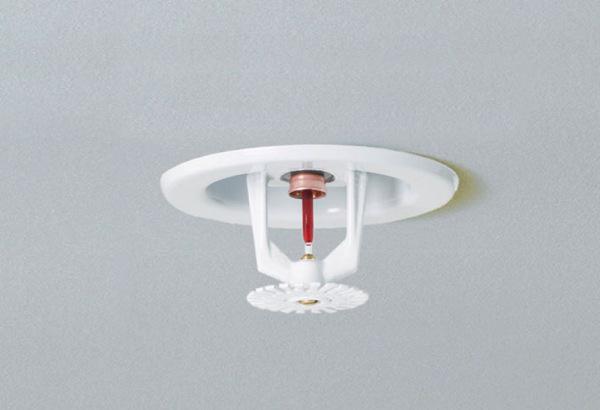
Systems are among the most common. In this case, an installation is considered, which includes a special sprinkler - the so-called sprinkler. This element is integrated into the piping system, which can be filled with air, foam or water. There are also combined models in which the supply pipeline system is always filled with water, and air can be used in the supply and distribution channels. water fire extinguishing are capable of determining the moment for performing their work without human intervention. Initially, the sprinkler is in a closed state, which is provided by a thermal lock. Upon reaching a certain temperature in environment depressurization of the closing flask occurs and after 5-10 minutes the installation starts fire extinguishing.
Deluge water ASPT
Despite the similarity of deluge installations with sprinkler installations, there are many fundamental differences... First, it is a different approach to fire detection. In such systems, the fire alarm system does not work due to temperature-sensitive bulbs and thermal locks, but with the help of external fire detectors, that is, fire alarms with accompanying sensors. Secondly, the water consumption in drencher ASPT is higher, and the irrigation system as a whole is more complicated. Built-in sprayers can deliver fine water droplets up to 150 microns. In this case, the irrigation nozzles are jet, gas-dynamic 2-phase, and can also be equipped with deflectors for splitting the jets. The most successful deluge water systems cope with the localization of fires, dividing areas into sectors, preventing the spread of heat sources and preventing the combustion of toxic substances.
Gas fire extinguishing
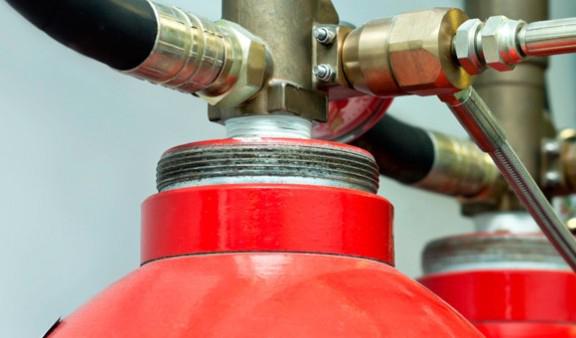
Modern ASPTs, which work with the use of gas extinguishing compositions, can be installed both in non-residential and residential premises. It depends on what kind of gas is used. Recently, manufacturers have provided for the use of compounds such as argonite and inergen, which are non-synthetic and do not have harmful effects on the atmosphere. The extinguishing principle in this case is based on the replacement of oxygen, a decrease in the content of which leads to a weakening of combustion. However, the installation of fire extinguishing systems on gas mixtures should also provide for the factor that a sharp drop in oxygen levels can contribute to discomfort in people who are in the room. Nevertheless, the main objects where the installation of automatic gas extinguishing systems is recommended are non-residential premises- server rooms, libraries, museums, banks and offices. This is due to the fact that in the process of extinguishing with gas material values are fully preserved.
Fire extinguishing systems design
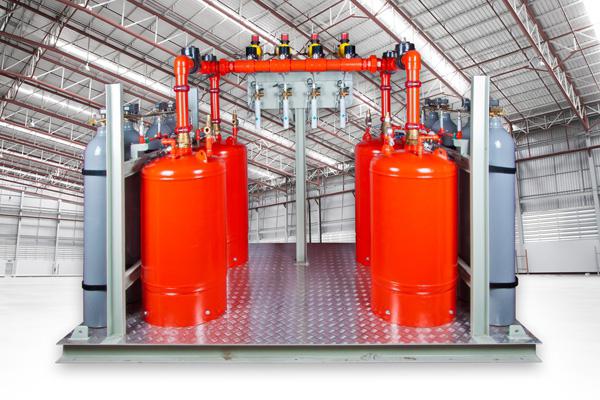
The main task facing the designers is the preparation of technical and budget documentation, which describes the system and its elements in finished form, and also provides the normative data for installation. The phased design of fire extinguishing systems can be presented as follows:
- Visit by specialists of the work site.
- Determination of the optimal type of extinguishing system.
- Preparation of technical specifications and its approval by the customer.
- Development of design documentation based on technical specifications.
- Coordination of the prepared documents in the supervisory authorities.
- Implementation of the technical part of the project in accordance with the standards.
Graphic design
For a visual display of the future fire extinguishing system, it is also necessary to develop graphic documentation. 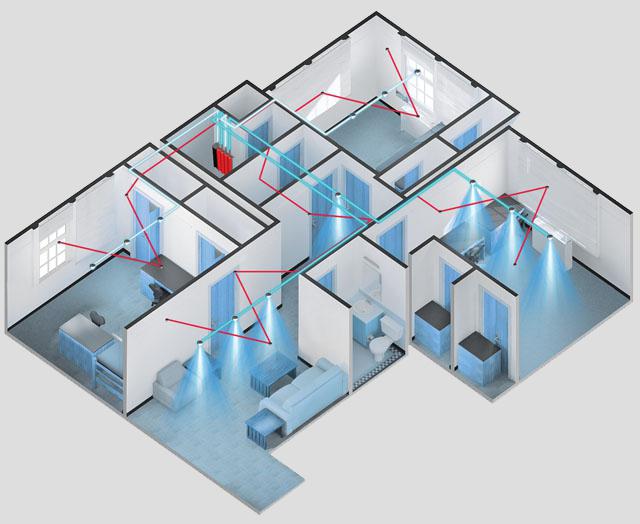 In this case, the authors must prepare a plan that will take into account the characteristics of a particular site where the object is located. In particular, the exit routes from the territory, the possibilities for the entrance of special equipment, the layouts of the water supply system, the arrangement of sprinklers, nozzles, hydrants and signaling devices are indicated. If used stationary systems fire extinguishing, it is also necessary to take into account the location of tanks and reservoirs with water and pumping stations. Schemes are also mandatory, on which routes for the evacuation of personnel, residents and material values are indicated. Planning a safe exit is carried out not only in relation to a specific building or structure, but also from the adjacent territory, within which the spread of fire is possible.
In this case, the authors must prepare a plan that will take into account the characteristics of a particular site where the object is located. In particular, the exit routes from the territory, the possibilities for the entrance of special equipment, the layouts of the water supply system, the arrangement of sprinklers, nozzles, hydrants and signaling devices are indicated. If used stationary systems fire extinguishing, it is also necessary to take into account the location of tanks and reservoirs with water and pumping stations. Schemes are also mandatory, on which routes for the evacuation of personnel, residents and material values are indicated. Planning a safe exit is carried out not only in relation to a specific building or structure, but also from the adjacent territory, within which the spread of fire is possible.
General rules for the installation of fire extinguishing systems
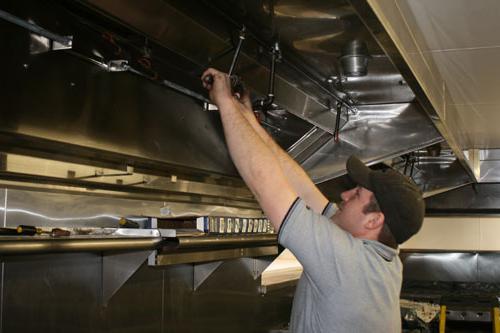
Depending on the type of system selected, the installation process may require electrical, plumbing and welding operations... The work of the wizard mainly involves fixing the elements of the system, as well as their connection into a common infrastructure by means of special nodes. The standard installation of an automatic fire extinguishing system includes the following works:
- Installation of sensors, indicators and other sensitive elements that detect signs of fire.
- Integration of elements that provide notification of an emergency situation.
- Installation of means at the expense of which the storage and subsequent transfer of substances intended for fire extinguishing is carried out.
- Installation of sprayers that directly perform the function of eliminating the fire.
An important element of such systems is the fire alarm, which can be part of the complex in the form of the mentioned sensors or perform a separate function of the detector.
Installation of water fire extinguishing
By by and large, the entire technical infrastructure of the ASPT is aimed at servicing the material with which fire fighting is carried out. In the case of water systems, the set of system components can be represented by a pumping station, a liquid reservoir, control units, a pipeline and irrigation devices. After design, the installation of an automatic fire extinguishing system of this type aims at the correct distribution and integration of elements into a common complex.
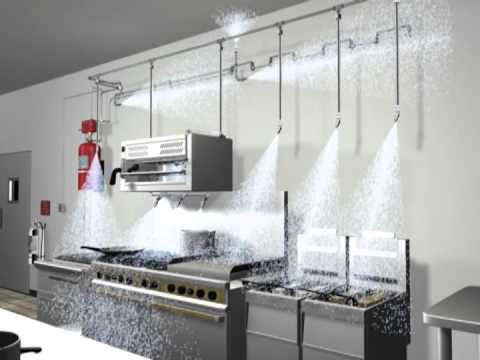
The pumping station may occupy a separate room, but in mandatory it is insulated with refractory screens. Optimal locations for the installation of sprinklers, these are ceiling surfaces and floor beams. But another principle of their integration is also possible, including a hidden one - it all depends on the threats of fire in a particular room. The nodes, with the help of which the operation of the alarm and fire extinguishing system is regulated, are located in a safe place, where free access by personnel is provided. The pipeline and the tank are connected to each other and can be connected to the central water supply, but only if sanitary standards are observed.
Service of ASPT
Activities for maintenance can be determined at the system design stage. As a rule, they provide for checking the elements of the complex for the correctness of the performance of functions and the state of the working resource. At the same time, the maintenance of fire extinguishing systems involves an analysis of the conditions in which the equipment is contained. If, for example, the nature of the operation of a room or building has changed, in accordance with it, adjustments should be made to the technical part of the complex.
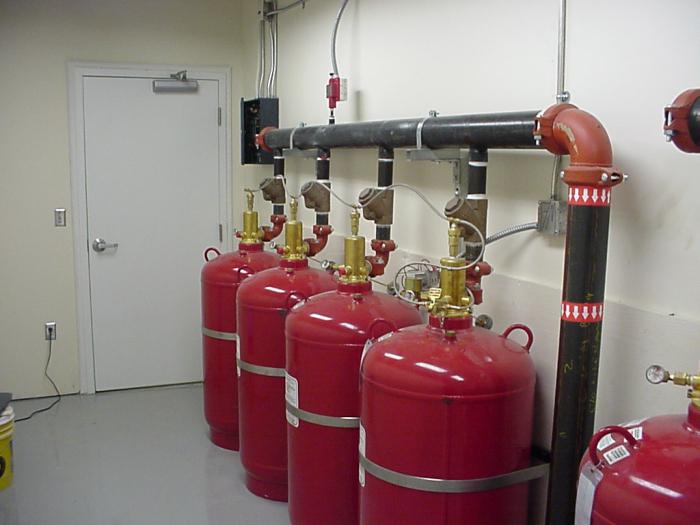
How much do ASPT cost?
There is no doubt about the usefulness of modern fire extinguishing systems, but when planning equipping with such equipment, one should prepare for significant costs. The cheapest solutions include autonomous complexes that include several modules. Powder-based systems with a typical layout for a small room can cost 11-13 thousand rubles. But in most cases, such a decision is difficult to do, and the installation of a fire extinguishing system is required, the cost of which can exceed 100 thousand rubles. For this amount, the customer receives full-fledged fire protection in the form of an automatic complex equipped with alarm sensors, a modern control point and extended functionality. The most expensive solution can be an ASPT with water mist, which includes several modules, united by a common control point. A similar system for equipping trading floor can cost about 500 thousand rubles.
Design of fire extinguishing and fire protection systems, development of project documentation
Fire Technologies Company is an expert in the field of fire safety! We welcome you and invite you to use our services! We are here for you!
Development of project documentation is carried out as soon as possible!
We will carry out for you the design of fire extinguishing and fire protection systems of any kind and of any complexity. We are not afraid of challenging tasks! We don't mind small objects!
After all, it is equally important to design a fire extinguishing system at any facility!
You can also order a free specialist consultation from us with a visit to the facility to determine the degree of its fire protection and probable threats. We will calculate right in your presence different variants fire extinguishing prices for you!
Purpose and types of proposed fire extinguishing systems
The installation of fire extinguishing systems solves a number of problems in cases where there is a possibility of a fire threat that cannot be prevented. And even at those facilities where, it would seem, the danger of a fire is minimal, designing a fire protection system and installing this system will save lives at the right time!
This requires, first of all, the development of design documentation of proper quality.
It is necessary to ensure the safety of people and property as much as possible. Modern systems make it possible to automatically detect and localize a fire, notify people about it and start a fire extinguishing mechanism.
We design the following types of fire extinguishing systems
- Sprinkler. Their action consists in supplying a fire-extinguishing composition to the place of fire by means of a pipeline equipped with sprinkler-type sprinklers. Such systems are equipped with special thermal locks that react to changes in the air temperature in the room. Development of design documentation for sprinkler systems is carried out by us inexpensively!
- Deluge. They are used as curtains of deluge-type sprinklers and foam generators, effectively cutting off the fire zone. This is the simplest and most economical way to contain a fire and extinguish it.
- Aerosol. When there is a danger of ignition of electrical equipment, the design of fire extinguishing systems of this type is most expedient. The aerosols used in them, effectively fighting fire, do not harm the materials and structures of power plants.
- Gas. They are triggered in the event of a decrease in the concentration of oxygen in the surrounding space, signaling a fire and supplying a fire extinguishing gas to the fire. Such fire protection systems are designed in a high-tech industrial production due to their safety for equipment.
- Foamy. This type is relevant for the detection and elimination of fires of increased complexity in places where flammable substances and materials are concentrated. In such systems, various operating principles can be applied, starting the supply of a foamed solution to the fire zone.
- Powder. The principle of their operation is to supply a fine powder composition to the place of ignition. This is the most optimal type of systems that allows you to detect and extinguish fires of all classes from A to D in rooms where other methods of extinguishing the fire are impossible. We design powder fire extinguishing systems with a guarantee of their subsequent correct operation!
Design of fire extinguishing systems - stages and features
Regardless of the choice of system in each case, we strictly adhere to the following design stages:
- analysis of the initial data on the customer's activity profile;
- visiting the facility with a survey of the protected area;
- development of the system project and its coordination with the customer;
- delivery of the final version of the project;
- technical control of works on its implementation.
As a member of SRO with extensive experience in fire-fighting equipment of various objects, we are fully responsible for the developed projects and give a guarantee for the work performed.
Customers who have already used our services continue to cooperate with the Fire Technologies company in servicing the installed equipment. Order the design of fire extinguishing and fire protection systems from us to make sure of the high competence of our specialists and impeccable service! If the development of the design documentation is carried out by our specialists, you can be sure of the flawless operation of the fire protection systems!
The design of automatic fire extinguishing installations is carried out taking into account the characteristics of the protected buildings and premises, the possibilities and conditions for the use of fire extinguishing agents based on the nature technological process, technical and economic indicators. The type of installation and the extinguishing agent must be selected taking into account fire safety and physical and chemical properties substances and materials that are manufactured, stored and used.
Do you want to install a fire extinguishing system?Water-based fire extinguishing systems are used to detect and eliminate fires, to protect people and property from the effects of fire. The extinguishing agent is plain water... Apply water fire extinguishing in shopping centers, hospitals, office buildings, hotels, warehouses and industrial premises. Using water fire extinguishing it is possible to completely eliminate 96% of fires of varying complexity.
Foam fire extinguishing is used to extinguish fires of solid and liquid substances, such as oil products, alkali metals... Such substances cannot be extinguished with water. Foam is used as a fire extinguishing agent. Foam fire extinguishing systems are used in the oil production and refining industries, at the enterprises of the heavy and chemical industries.
Gas fire extinguishing systems are used in rooms where it is necessary to ensure the maximum safety of the objects present there. These can be computer rooms, banks, data archives, objects of art and culture, production and industrial premises... Fire extinguishing agents are gaseous compounds.
Our objects
Hotel and restaurant complex "Europe" 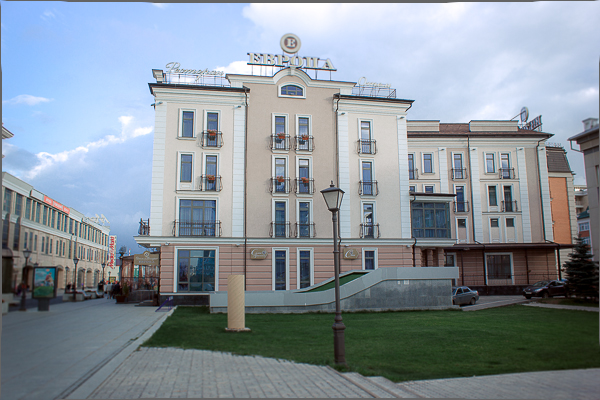
Porsche dealership 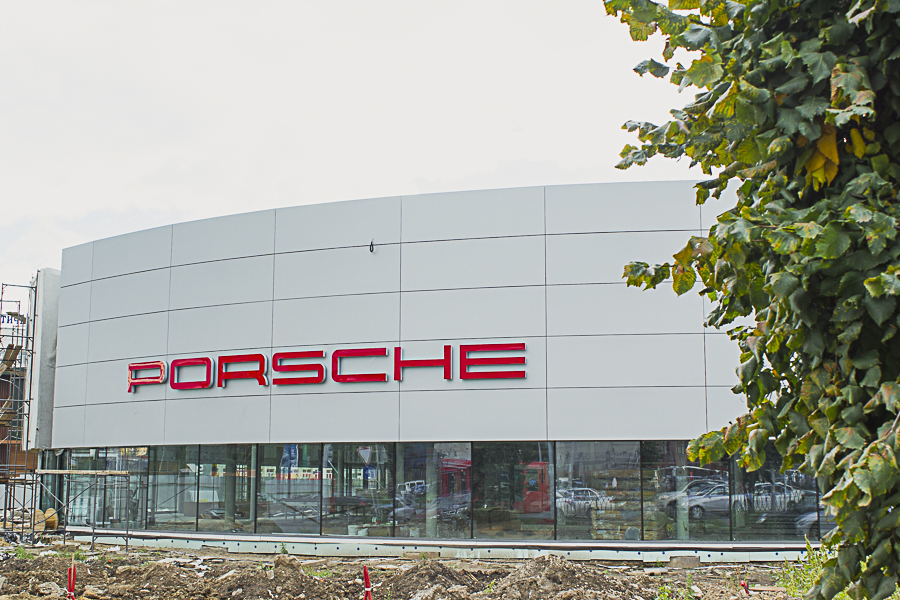
Powder fire extinguishing systems are used to fight fires of classes A, B, C, D, E (fires with ignition of solid, liquid and gaseous substances, electrical equipment and electrical installations). Installed this system fire extinguishing in the premises of archives, museums, libraries, equipment rooms. Powder compositions are used as a fire extinguishing agent.
Aerosol fire extinguishing is based on the use of products formed during the combustion of an aerosol mixture. Aerosol fire extinguishing installations are used at industrial and administrative facilities, in residential buildings, garages, river and sea vessels.
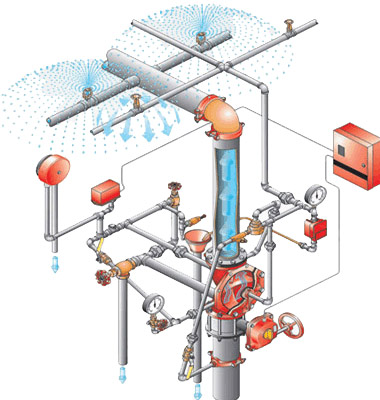
When designing a fire extinguishing system, a huge number of different factors are taken into account. First of all, they carefully analyze the object for which the fire extinguishing design is being carried out. They study the features of architecture, its purpose, the availability of equipment and personnel. For industrial premises take into account the nature of production. They take into account whether the living space, as well as the presence of energized equipment in it. During the design of fire extinguishing installations, the temperature indicators of the object are taken into account. So water and foam fire extinguishing is used in rooms with a stable positive temperature. Powder and gas fire extinguishing is indispensable in unheated rooms. The presence of material assets in the protected room is also taken into account when designing automatic fire extinguishing... Using gas and powder installations, they ensure the safety of valuable objects. The amount of extinguishing agent in the fire extinguishing system should be optimal to protect at least the largest protected room or group of rooms that are simultaneously protected. If necessary, a reserve of extinguishing agent must be provided for multiple duplication of its release.
Fire extinguishing design work process
- Pre-project inspection of the facility, consulting.
- Estimated calculation of design work, agreement of a contract for the performance of work.
- Development of a technical solution (Choice of an automatic fire extinguishing system: water, foam, gas, autonomous), drawing up a technical task.
- Water and foam fire extinguishing system: - sprinkler, sprinkler with forced start-up, deluge, sprinkler-deluge and robotic, installations with water mist, installations with high expansion foam.
Gas extinguishing system: modular, centralized fire extinguishing installations.
Standalone installations fire extinguishing: liquid, foam, gas, powder. - Hydraulic calculation, selection of equipment pumping station.
- Selection of equipment, coordination with the Customer (price, quality).
- Coordination of the location of the pumping station, fire extinguishing installation with the Customer.
- Project development.
- Delivery of project documentation.






